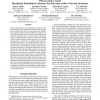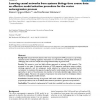2499 search results - page 336 / 500 » The Serializability of Network Codes |
117
click to vote
AAAI
2006
14 years 11 months ago
2006
Intrusion attempts due to self-propagating code are becoming an increasingly urgent problem, in part due to the homogeneous makeup of the internet. Recent advances in anomalybased...
105
click to vote
BMCBI
2007
14 years 10 months ago
2007
Background: Causal networks based on the vector autoregressive (VAR) process are a promising statistical tool for modeling regulatory interactions in a cell. However, learning the...
PERCOM
2011
ACM
14 years 2 months ago
2011
ACM
— This paper focuses on the problem of rostering in intermittently connected passive RFID networks. It aims to report a list of tagged mobile nodes that appear in given intereste...
110
click to vote
EUROSYS
2007
ACM
15 years 7 months ago
2007
ACM
Virtual memory has been successfully used in different domains to extend the amount of memory available to applications. We have adapted this mechanism to sensor networks, where,...
NDSS
2008
IEEE
15 years 4 months ago
2008
IEEE
Protocol reverse engineering is the process of extracting application-level specifications for network protocols. Such specifications are very helpful in a number of security-re...


